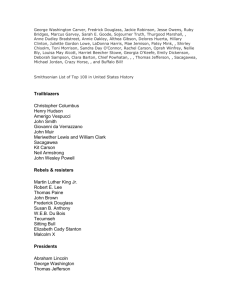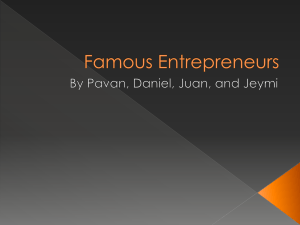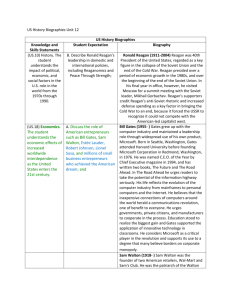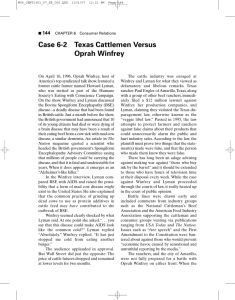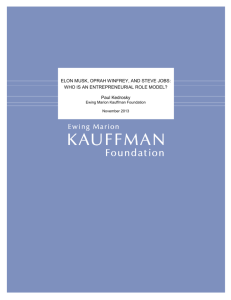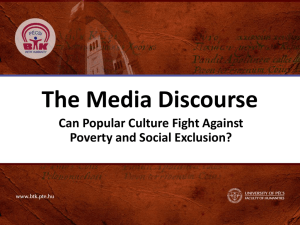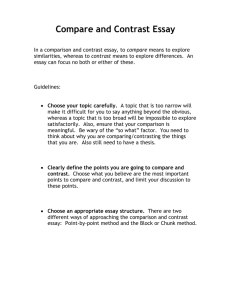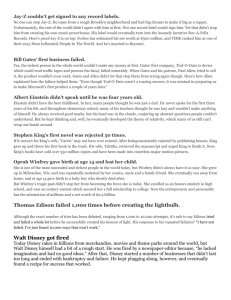Reading Oprah Winfrey: fantasy, desire and the (never) good
advertisement
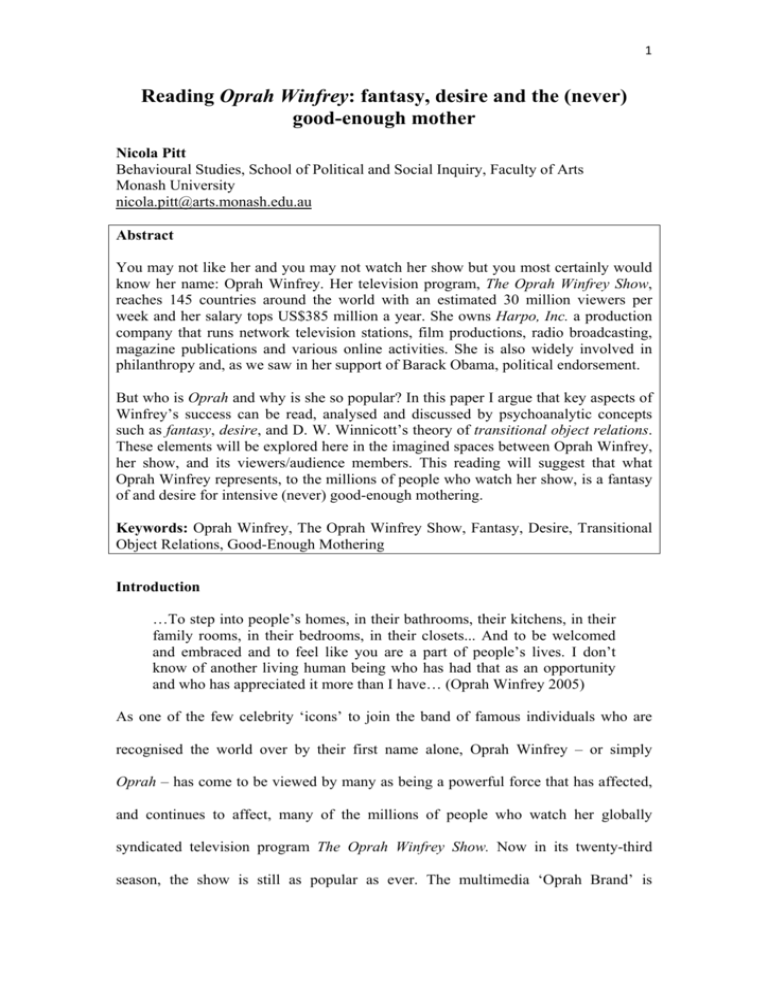
1 Reading Oprah Winfrey: fantasy, desire and the (never) good-enough mother Nicola Pitt Behavioural Studies, School of Political and Social Inquiry, Faculty of Arts Monash University nicola.pitt@arts.monash.edu.au Abstract You may not like her and you may not watch her show but you most certainly would know her name: Oprah Winfrey. Her television program, The Oprah Winfrey Show, reaches 145 countries around the world with an estimated 30 million viewers per week and her salary tops US$385 million a year. She owns Harpo, Inc. a production company that runs network television stations, film productions, radio broadcasting, magazine publications and various online activities. She is also widely involved in philanthropy and, as we saw in her support of Barack Obama, political endorsement. But who is Oprah and why is she so popular? In this paper I argue that key aspects of Winfrey’s success can be read, analysed and discussed by psychoanalytic concepts such as fantasy, desire, and D. W. Winnicott’s theory of transitional object relations. These elements will be explored here in the imagined spaces between Oprah Winfrey, her show, and its viewers/audience members. This reading will suggest that what Oprah Winfrey represents, to the millions of people who watch her show, is a fantasy of and desire for intensive (never) good-enough mothering. Keywords: Oprah Winfrey, The Oprah Winfrey Show, Fantasy, Desire, Transitional Object Relations, Good-Enough Mothering Introduction …To step into people’s homes, in their bathrooms, their kitchens, in their family rooms, in their bedrooms, in their closets... And to be welcomed and embraced and to feel like you are a part of people’s lives. I don’t know of another living human being who has had that as an opportunity and who has appreciated it more than I have… (Oprah Winfrey 2005) As one of the few celebrity ‘icons’ to join the band of famous individuals who are recognised the world over by their first name alone, Oprah Winfrey – or simply Oprah – has come to be viewed by many as being a powerful force that has affected, and continues to affect, many of the millions of people who watch her globally syndicated television program The Oprah Winfrey Show. Now in its twenty-third season, the show is still as popular as ever. The multimedia ‘Oprah Brand’ is 2 constituted through things like the official Oprah.com website, ‘O’ The Oprah Magazine, and Oprah’s Book Club. This brand supports and articulates the phenomenon that is first and foremost associated with the woman that is and stands behind the name Oprah. But who is Oprah Winfrey and why is she so popular? In this paper—which draws on my PhD research exploring diverse manifestations of discourses of intensive mothering (cf. Pitt 2008)—I will argue that key aspects of Winfrey’s success can be read, analysed and discussed by psychoanalytic concepts such as fantasy, desire, and D. W. Winnicott’s theory of transitional object relations. These elements will be explored here in the imagined spaces between Oprah Winfrey, her show, and its viewers/audience members. What these aspects of the Oprah phenomenon and elements of psychoanalytic/ object relations theory hold together is, I suggest, a Winnicottian-type of ‘facilitating environment’ (1965b:96-100) whereby we, in both a general and possibly all-inclusive sense, are nurtured and cared for, looked after and loved in a two-way relationship that resembles that of a mother and her child. This reading, which sits ambivalently alongside other readings that are more certain and less ambiguous in their critique of Oprah the person and what Oprah the phenomenon suggests about the state of western culture at the start of the 21st century, enables me to suggest that what Oprah Winfrey represents, to the millions of people who watch her show, is a fantasy of and desire for intensive (never) good-enough mothering. Reading Oprah: a role model for motherhood? …I think it is a privilege to have this as your work… to say that you can use your voice. And your voice isn’t just what comes out of your mouth, but it is what comes from the interior of your soul. To speak to people in a way that allows them to see the best of themselves… and for that, I am eternally grateful. (Winfrey 2005) 3 In 2005 Oprah Winfrey celebrated the 20th anniversary of her award-winning television show. It was also the year in which she turned fifty. Currently running its twenty-third season, Winfrey has signed on for another three years which will see The Oprah Winfrey Show potentially close some twenty-five years since it was first aired in 1986. With an annual salary that tops US$385 million and a net worth of US$2.7 billion (Forbes400 2009), Winfrey is showing no signs of stopping, even if and when her show does. Reaching 145 countries around the world, with an estimated 30 million viewers per week, The Oprah Winfrey Show, run by Winfrey’s multimedia production company, Harpo, Inc., has received numerous acknowledgments and awards including more than 40 Daytime Emmy Awards – seven of which were for Outstanding Host and nine for Outstanding Talk Show. In 1998 Winfrey received a Lifetime Achievement award from the National Academy of Television and in 2002 she was inducted into Broadcasting and Cable’s Hall of Fame (Oprah.com 2009). In addition to these achievements, Oprah Winfrey is the only person to have been listed six times on the Time100 List of ‘Most Influential People’ from 2004-2009 and in 1999 for being one of the most influential people of the 20th century. TimesOnline describes Winfrey’s influence in the following ways: creating an intimate confessional form of media communication to popularising and revolutionising the tabloid talk show genre: being an inspirational role model: her work in relation to book-reading and the publishing industry: helping to elect the first African-American president, Barack Obama. Winfrey is more than just a ‘TV talk show host’. She is also a global icon, a leader, a teacher, a philanthropist, and a role model for many. Indeed Janice Peck (2008) has suggested that we know Oprah more than any other celebrity, and with that, it would seem that we have also come to read, analyse and seek understandings about her from a wide range of perspectives. Perhaps it is 4 Winfrey’s ‘rags to riches’ (Cloud 1996: 115) biography that embodies successfully pursuing ‘the American Dream’ that we come to know a particular story, or stories, that we associate with the Oprah brand. But there are also a number of other frameworks, discourses, structures and/or other concepts available for us to make sense of the Oprah Winfrey phenomenon from the outside. While it is not within the parameters of this paper to explore the variety of complex, multiple, possibly contradictory, possibly shared meanings that such a phenomenon might be producing, what I offer here instead is a brief survey of some of the issues. Within the current literature there is the suggestion of seven key discourses available to make sense of Oprah Winfrey in particular, and in most cases, fairly specific ways: 1. Narrative/Biography, Celebrity ‘Star’ Discourses: In these discourses, Winfrey’s biographical narrative is seen to resonate and reinforce the ideology of the ‘American Dream’. Oprah’s personal ‘legend’ also becomes part of her fame and celebrity story which is a narrative in itself. (see Cloud 1996; Cooper 2007; Illouz and John 2007; Lowe 1998; Wilson 2003) 2. Therapeutic Culture/Confessional Discourses: Here it is suggested that Winfrey acts as a (pseudo) therapist in a very public, global forum. Where experience becomes the source of authority, the Oprah Winfrey Show provides living knowledge as being useful to the lives of everyday people via the confessional form of discourse and testimony between the host and her guests. (Abt and Seesholtz 1994; Andersen 1995; Shattuc 1997; Smith-Shomade 2008) 3. Day Time ‘Trash TV’ Talking Cure Discourses: 5 Tabloid television and the nature of the talk-show genre as a broadcast discourse features interactively in the context of (mass) media communication. An event that is host-controlled, participant-shaped and audience-evaluated, daytime talk involves the classical art of conversation which can be analysed for the semi-institutional nature of its dialogue. (Abt and Seesholtz 1994; Ilie 1999, McLeod and Wright 2009; Nudelman 1997) 4. Gender/Sexuality Discourses: A number of feminist theorists concern themselves with Winfrey’s position (and success) as a woman in her patriarchical field but also as problematically reproducing normative heterosexuality on her show. (Epstein and Steinberg 1995; Epstein and Steinberg 1996; Squire 1994) 5. ‘Race’/Class Discourses: Discourses of black feminism are interested in the colour of Winfrey’s skin and what effects this has had in relation to her successes, her audiences, and her projection of self in the media. (Illouz 1999; Kay 2007; Squire 1994; Stanley 2007) 6. The ‘Oprah Effect’ and Women’s Emotional Intimacy/Friendship Discourses: Winfrey’s intimacy on-camera seems to invite her audience to enter into a ‘parasocial’ relationship with her whereby viewers, especially females, feel like they are friends with her on a personal level. (Haag 1993; Harris and Watson 2007; McLeod and Wright 2009; Nudelman 1997) 7. ‘Poprah’ and the ‘religion of Oprah’/Political Endorsement Discourses: It has been suggested that Oprah is akin to a religion as well as that Winfrey should run for president. These discourses hint at the roles of Winfrey as 6 representing a teacher, a spiritual leader and a politically-savvy power-house. (Baum 2005; Glynn et al. 2007; Pease and Brewer 2008; Peck 2008) This list is far from exhaustive, and leaves out a variety of other important aspects concerning the Oprah brand such as consumerism, super-realism, spectatorship and even discourses of subjectivity and meaning. What I would like to suggest in the remainder of this paper is the possibility of another discourse, an eighth key discourse that argues Winfrey’s position as a mother – or ‘role mother’ at least – to the many individuals all around the world who watch and listen eagerly to what she has to say. This reading of Oprah (as a discourse for motherhood) emerges from certain object relations/ psychoanalytic understandings of fantasy and desire. Fragments of psychoanalytic theory: fantasy, desire and the maternal body In early-21st century contexts mothers are inundated with contradictory demands associated with maternal propriety. What constitutes ‘good-enough’ behaviour is subjective and ever-changing and, as a consequence, women’s desires to be good enough mothers can result in feelings of ambivalence, fear, and anxiety when failing to measure up to perceived expectations (Hollway and Featherstone 1997). This sort of intensive mothering (Hays 1996) can be viewed as a ‘motherhood mandate’ which declares mothering as being exclusively women’s work, wholly child-centred, emotionally involving, and time-consuming (Arendall 2000:3). The ideology of intensive mothering, as Sharon Hays (1996) argues, has become a gendered, contemporary, and problematic model of socially appropriate maternal behaviour that advises women to dedicate almost all of themselves to the activities of child-rearing. The fantasy and role of a maternal body incorporates the intensity and emotional closeness of an idealised mother-child relationship which Ann Phoenix and Anne 7 Woollett (1991:6) argue is necessary for the healthy development of a child. Mothers are seen as ‘supporters’, ‘matrices’, ‘holding environments’, or ‘self-objects’ who ‘supply, gratify, mirror and “develop” children’ (Weingarten et al. 1998:2), and the predominant images of contemporary western mothers are ‘ever-bountiful, evergiving, and self-sacrificing (Bassin, Honey, and Kaplan 1994:3). This image however, contradicts with the practical situations that many individual mothers may find themselves in. The image of intensive mothering, suggests Hays (1996:21) is a historically constructed cultural model for appropriate child-care that is ‘we are told’, ‘the best’ model for mothering because it is the sort of mothering that ‘children need and deserve’. Object Relations theorist D. W. Winnicott (1965a:17) first coined the term ‘goodenough mothering’ to capture a range of elements and processes in childhood development. This theory of transitional (or object) relations offers a psychoanalytic account of the emotional dialogue between a mother and her child. It is the idea that through a mother’s caring for and playing with her children, an infant may be able to cope with the emotional work of learning to be an independent and separate being (Winnicott 1971:1-6). Essentially, it is about the mother’s role in providing the right kind of support necessary for a child’s emerging sense of self. In a series of essays and broadcasts that were geared towards advising mothers on how to be ‘good-enough’, Winnicott (1965a; 1971:10) took the view that in life, we are not necessarily mesmerised by death and destruction as argued by Freud or Melanie Klein. Rather, he suggested that we long for the original bliss of total acceptance, recognition and plenitude that was provided to us in the first ‘unintegrated’ state of pure unity with the mother (cited in Minsky 1996:113). Winnicott (1965b) is inherently optimistic about a mother’s capacities, and 8 capabilities, for providing this supposedly natural, instinctive, and warm holding—or facilitating—environment for her child. Furthermore, through a mother’s primary maternal preoccupation—the idea that she naturally becomes consumed and obsessed by ‘the joys’ of motherhood—with her child, this special sort of presence, or devotion, allows the child to experience itself as omnipotent and self-identical (Elliott 2002:74-75). It was Winnicott’s view (1965a:15) that the mother brings to the situation of child-rearing a certain capacity, or particular ‘attitude’ that would will her to ‘drain interest from her own self onto the baby’. Thus the quality of a woman’s primary maternal preoccupation with her child would affect the quality of the object-relation between the child and its mother. These particular sorts of interactions, Winnicott (1965b) suggested, establish the type of being experienced by the child and, he argued further, that only through good-enough mothering can a child develop good (enough) experiences of being an independent self. Despite transforming the mother’s place in child development through emphasising the importance of a mother’s role, Winnicott’s theories are hardly liberating for women (cf. Doane and Hodges 1992). Although Winnicott sought to advise mothers, he remained insistent that a mother would naturally know what the needs of her children were (at all times). While feminist psychoanalysts/object relations theorists such as Jessica Benjamin (1988) and Nancy Chodorow (1978) have usefully critiqued and appropriated Winnicott’s work, I maintain here that the ability to know when and how to relinquish control, or support separation, is not only about being good-enough: it requires ‘godlike’ maternal instincts of being able to interpret the needs and signals of the infant, as well as taking full-responsibility for the child’s healthy development of self. Christine Everingham (1994:11) has even gone so far as to suggest that the 9 notion of good-enough mothering actually creates the desire for a ‘near perfect caregiving environment’ that becomes impossible to achieve or provide. Oprah, Earth mother? Nurturing an intensive capacity to care …the greatest thing about what I do, for me, is that I'm in a position to change people's lives. It is the most incredible platform for influence that you could imagine, and it's something that I hold in great esteem and take full responsibility for. (Entertainment Executive 1991) A text such as The Oprah Winfrey Show illustrates a type of mothering that is intensive in multiple ways. Winfrey’s desire to always ‘do better,’ and ‘be better,’ appeals to women’s desires to be good-enough mothers and it can be argued that it is this appeal that underpins the show’s success. I am suggesting that the daily one hour time-slot offers a Winnicottian type of transitional space, a phenomenon which Elliott (2004:26) argues is ‘a fundamental means for a mature, reflective involvement in social and cultural life, since it allows for the exploration of fantasy and affect in symbolic terms’. Winnicott (1971:2) designated the term ‘transitional phenomena’ to the intermediate area of experience ‘between the thumb and the teddy bear’. The show itself can be seen to represent this area of experience: a complex fantasy of relations, interactions, feelings and possibly mutual understandings between Winfrey and her audience: Oprah is there for us, and we are there for her too. In 1996, Joni Jacques was an audience member on the The Oprah Winfrey Show. Winfrey (2005) asked Jacques to share her story about ‘Oprah’s shoes’ with he audience. Joni tells us that a few years back, when she was very poor, she came to Oprah’s charity sale and purchased the cheapest item available: a pair of black shoes, size ten. Although Joni was only a size seven, she took them home and kept them in her bedroom. Each time she was feeling alone or depressed, Joni said she would put them on and it would make her feel better. ‘She stood in my shoes!’ Oprah cried out 10 loud. ‘The very idea that someone would physically stand in your shoes,’ Winfrey recollects, ‘and because of that, feel strengthened, is a reason to be alive… that somebody can take what you have to offer and allow that to move them forward, higher… in their own being, that’s success… that’s it, that’s why you live’. This form of confession and testimony that we see from Winfrey is then mirrored by participants, audience members, and possibly viewers who are watching the show from home. The show offers a safe space in which to open up, express one’s emotions, and learn from the experience—all with the kind and gentle guidance of Winfrey sitting comfortably on her couch ‘next to’ us. Sherryl Wilson (2003:6) describes this sort of space as a ‘borderzone’—the Winnicottian facilitating/holding environment— that allows an interaction between the outer social world of laws and values, and an inner world of private experience. New forms of subjectivity can be created through learning and being open to new ways of thinking which are provided for by Winfrey and the particular episode’s topic or issue. We can become attached to guests, the content, Winfrey herself. ‘This show is more than a show’, says Winfrey (2005), ‘you are affecting the way people see themselves, and you have an opportunity to do that every time someone turns on the TV’. For twenty-three yeas and counting, Oprah Winfrey has offered support, advice, parenting tips, and one-hour a day inspirations on how to become a better person, make better choices, and live a better life. I suggest that Winfrey embodies a motherfigure, possibly an Earth-Mother even, to people all around the world. She offers a construction of selfhood that is recognisable to a mass audience: one that reflects the complexity of contemporary culture, and also the attractive potential for a positive, meaningful, and healthy existence (Wilson 2003). The show frequently presents stories of experiences that involve overcoming obstacles, and the revelation of a 11 trauma is often accompanied by testimonies of endurance and survival. It is in this sense that Oprah can be viewed as representing a caring and nurturing global earth mother-figure. This mother-figure not only provides a safe and warm nurturing environment within the spaces of her show, but also continually seeks to become better in order to improve and enrich the lives of many individuals. But her choices as an independent, wealthy, famous, single African American woman have included not having any children of her own. She has made it clear that this was her choice to do so. By not having children, Winfrey continues to pursue her alreadysuccessful career, always striving to do more, be more, and deliver more to the audience (or what might be called her children-figures). Conclusion: ambivalence and complexity in reading Oprah Reading Oprah Winfrey and The Oprah Winfrey Show provokes ambivalence and complexity – certainly, even in my own personal engagement with the Oprah brand and all that is Oprah I am continually perplexed and sometimes even troubled by the enormous power and reach that Winfrey has around the world. But it is this global and diverse influence which makes a reading—indeed many readings—of her interesting, ambivalent, complex, and significant. Along with a desire to be a good-enough mother-figure, Oprah can also represent an object for desire, or an object of fantasy. This object—the maternal body—embodies cultural formations, constructions of self, and a display of the spectacle which many women (of mixed racial backgrounds) are able to feel comforted by. It is in the context of a psychoanalytic reading of intensive mothering and the discourses that are both produced and reproduced in the desires and fantasies to mother that The Oprah Winfrey Show can, in this instance, represent a desire for the ‘near perfect care-giving 12 environment’ which Everingham (1994:11) describes as forming an intrinsic part of the good-enough mother’s responsibilities and duty to provide. But if Oprah Winfrey can never really be good-enough (always trying to do more, be more, and provide more) then perhaps the desires and fantasies of ‘real’ mothers’ attempts to be goodenough mothers has come to mean that any mother, just like Oprah herself, can never really be or feel good-enough at all. Acknowledgments I would like to thank Dr Peter Kelly and Fiona Brookes for their comments regarding the development of this paper. References Abt, V. and Seesholtz, M. (1994) ‘The shameless world of Phil, Sally and Oprah: Television talk shows and the deconstructing of society’, Journal of Popular Culture, Vol. 28(1): 171-91. Andersen, R. (1995) Consumer Culture and TV Programming, Colorado: Westview Press. Arendall, T. (2000) ‘Conceiving and investigating motherhood: The decade's scholarship’, Journal of Marriage and the Family, Vol. 62: 1192-1207. Bassin, D., Honey, M. & Kaplan, M. M. (Eds.) (1994) Representations of Motherhood, New Haven: Yale University Press. Baum, M. (2005) ‘Why presidential candidates hit the talk show circuit’, American Journal of Political Science, Vol. 49(2): 2130-234. Benjamin, J. (1988) The Bonds of Love: Psychoanalysis, Feminism and The Problem of Domination, London: Virago. Chodorow, N. (1978) The Reproduction of Mothering: Psychoanalysis and the Sociology of Gender, Berkeley: University of California. Cloud, D. L. (1996), ‘Hegemony or Concordance? The Rhetoric of Tokenism in ‘Oprah’ Winfrey’s Rags-to-riches Biography’, Critical Studies in Media Communication, Vol. 13: 115-137. Cooper, I. (2007) Up Close: Oprah Winfrey, A Twentieth Century Life, New York: Viking Penguin Group. Doane, J. and Hodges, D. (1992) From Klein to Kristeva: Psychoanalytic Feminism and the Search for the ‘Good Enough’ Mother, Michigan: The University of Michigan Press. Elliott, A. (2002) Psychoanalytic Theory: An Introduction, Durham: Duke University Press. Elliott, A. (2004) Subject to Ourselves: Social Theory, Psychoanalysis and Postmodernity, 2nd Ed. Boulder: Paradigm Publishers. 13 Entertainment Executive (1991) ‘Interview: Oprah Winfrey’, Academy of Achievement: A Museum of Living History, Est. 1961 Washington D.C., last accessed 19 July 2009: <http://www.achievement.org/autodoc/printmember/win0int-1>. Epstein, D. and Steinberg, D. L. (1996), ‘All Het Up!: Rescuing Heterosexuality on The Oprah Winfrey Show’, Feminist Review, Vol. 54: 88-115. Epstein, D. and Steinberg, D. L. (1995), ‘Twelve Steps to Heterosexuality? Common Sensibilities on The Oprah Winfrey Show’, Feminism and Psychology, Vol. 5(2): 275-80. Everingham, C. (1994) Motherhood and Modernity: An Investigation into the Rational Dimension of Mothering, NSW: Allen and Unwin. Forbes400 (2009) ‘The World’s Billionaires – Number234: Oprah Winfrey’, last accessed 19 July 2009: <http://www.forbes.com/lists/2009/10/billionaires2009-richest-people_Oprah-Winfrey_O0ZT.html>. Glynn, C. J., Huge, M., Reineke, J. B., Hardy, B. W. Shanahan, J. (2007) ‘When Oprah intervenes: Political Correlates of the day time talk show viewing’, Journal of Broadcasting and Electronic Media, Vol. 51(2): 228-244. Hays, S. (1996) The Cultural Contradictions of Motherhood, New Haven: Yale University Press. Haag, L. L. (1993) ‘Oprah Winfrey: The construction of intimacy in the talk show setting’, Journal of Popular Culture, Vol. 26(4) 115-121. Harris, J. and Watson, E. (Eds.) (2007) The Oprah Phenomenon, Kentucky: University of Kentucky. Hollway, W. and Featherstone, B. (Eds.) (1997) Mothering and Ambivalence, London: Routledge. Ilie, C. (1999) ‘Semi-institutional discourse: The case of TV talk shows’, Journal of Pragmatics, Vol. 33: 209-254. Illouz, E. (1999) ‘That shadowy realm of the interior: Oprah Winfrey and Hamlet’s Glass’, Journal of International Cultural Studies, Vol. 2(109): 119-131. Illouz, E. and John, N. (2007) ‘Oprah Winfrey and Women’s Autobiography: A Televisual Performance of the Therapeutic Self’ in J. Harris and E. Watson (eds.) The Oprah Phenomenon, Kentucky: University of Kentucky, p. 87-100. Kay, L. (2007) ‘My Mom and Oprah Winfrey: Her Appeal to White Women’, in J. Harris and E. Watson (Eds.) The Oprah Phenomenon, Kentucky: University of Kentucky, p. 51-64. Lowe, J. (1998) Oprah Winfrey Speaks: Insight from the World’s Most Influential Voice, New York: John Wiley and Sons. McLeod, J. and Wright, K. (2009) ‘The talking cure in everyday life: Gender, generations and friendship’, Sociology, Vol. 43(1): 122-139. Nudelman, F. (1997) ‘Beyond the Talking Cure: Listening to Female Testimony on The Oprah Winfrey Show’, In J. Pfister and N. Schnog, (Eds.) Inventing the Psychological: Toward a Cultural History of Emotional Life in America, Yale: Yale University, p. 297-316. Oprah.com, ‘The Press Room’, Harpo Productions, Inc (2008), last accessed 18 July 2009: <http://www.oprah.com/entity/pressroom>. Pease, A. and Brewer, P. R. (2008) ‘The Oprah Factor: The effects of a celebrity endorsement in a presidential primary campaign’, Press/Politics, Vol. 13(4): 386-400. Peck, J. (2008) The Age of Oprah: Cultural Icon for the Neoliberal Era, Boulder: Paradigm Publishers. 14 Phoenix, A. & Woollett, A. (1991) ‘Introduction’ and ‘Motherhood: Social Construction, Politics and Psychology’, in A. Phoenix, A. Woollett, and E. Lloyd, (Eds.) Mothering: Meanings, Practices and Ideologies, London: Sage Publications, p. 1-13. Pitt, N. (2008) ‘Discourses of Intensive Mothering in the 21st Century: Yummy Mummies, The (Never) Good-Enough Mother and The Mommy Wars’ Honours Thesis for Behavioural Studies (PSI) in the Faculty of Arts, Melbourne: Monash University. Shattuc, J. M. (1997) The Talking Cure: TV Talk Shows and Women, New York: Routledge. Smith-Shomade, B. E. (2008) ‘You'd Better Recognize: Oprah the Iconic and Television Talk’, in C. Brunsdon & L. Spigel, (Eds.) Feminist Television Criticism: A Reader, 2nd Ed. New York: Open University Press, p. 111-138. Stanley, T. L. (2007) ‘The Specter of Oprah Winfrey: Critical Black Female Spectatorship’, in J. Harris and E. Watson (eds.) The Oprah Phenomenon, Kentucky: University of Kentucky, p. 35-50. Squire, C. (1994) ‘Empowering women? The Oprah Winfrey Show’, Feminism and Psychology, Vol. 4(1): 63-71. TimesOnline, ‘The Time100’, Article by Deborah Tannen Copyright 2009, last accessed 18 July, 2009: <http://www.time.com/time/time100/artists/profile/winfrey3.html>. Weingarten, K., Surrey, J. L., Coll, C. G. and Watkins, M. (1998) ‘Introduction’, in C. G. Coll, J. L. Surrey, and K. Weingarten, (Eds.) Mothering Against the Odds: Diverse Voices of Contemporary Mothers, New York: The Guilford Press, p. 1-15. Winfrey, Oprah in The Oprah Winfrey Show 20th Anniversary Special, DVD (2005) Paramount Pictures, Harpo, Inc. (Disc 1-2). Wilson, S. (2003) Oprah, Celebrity and Formations of Self, Houndmills: Palgrave Macmillan. Winnicott, D. W. (1971) Playing and Reality, London: Tavistock Publications. Winnicott, D. W. (1965a) The Family and Individual Development, London: Tavistock Publications. Winnicott, D. W. (1965b) The Maturational Processes and the Facilitating Environment, London: Hogarth Press and The Institute of Psycho-analysis.
